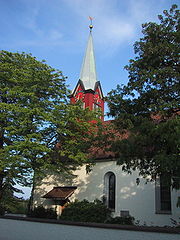
Neukirch an der Thur
Encyclopedia

Switzerland
Switzerland name of one of the Swiss cantons. ; ; ; or ), in its full name the Swiss Confederation , is a federal republic consisting of 26 cantons, with Bern as the seat of the federal authorities. The country is situated in Western Europe,Or Central Europe depending on the definition....
.
In 1996 the municipality was merged with the other, neighboring municipalities Buhwil
Buhwil
Buhwil is a village and former municipality in the canton of Thurgau, Switzerland.It is first mentioned in 838 as Puabinwilare.The municipality had 320 inhabitants in 1850, which decreased to 283 in 1900 and 282 in 1950...
, Kradolf
Kradolf
Kradolf is a village and former municipality in the canton of Thurgau, Switzerland.It was first recorded in year 883 as Chreinthorf.The municipality had 147 inhabitants in 1850, which decreased to 228 in 1880, 649 in 1900 and 1,064 in 1920...
and Schönenberg an der Thur
Schönenberg an der Thur
Schönenberg an der Thur is a village and former municipality in the canton of Thurgau, Switzerland.In 1996 the municipality was merged with the other, neighboring municipalities Buhwil, Kradolf and Neukirch an der Thur to form a new and larger municipality Kradolf-Schönenberg.Schönenberg an der...
to form a new and larger municipality Kradolf-Schönenberg
Kradolf-Schönenberg
Kradolf-Schönenberg is a municipality in Weinfelden District in the canton of Thurgau in Switzerland.The municipality was created in 1996 by a merger of Buhwil, Kradolf, Neukirch an der Thur and Schönenberg an der Thur.-History:...
.
Neukirch an der Thur is first mentioned in 1291 as Eliswil. In 1296 it was mentioned as Sêliswille, which remained its name until the Protestant Reformation
Protestant Reformation
The Protestant Reformation was a 16th-century split within Western Christianity initiated by Martin Luther, John Calvin and other early Protestants. The efforts of the self-described "reformers", who objected to the doctrines, rituals and ecclesiastical structure of the Roman Catholic Church, led...
. After 1520 it was known as Nüwenkilchen.
The population in 1850 was 2,546. It decreased in 1900 to 1,921 and continued to drop so that in 1950 it was 1,879. By 1990 it had increased slightly to 1,997.

